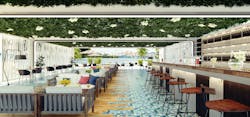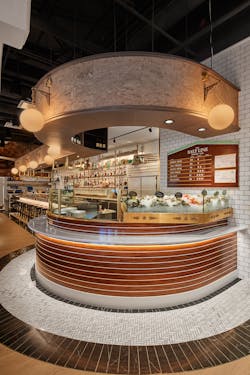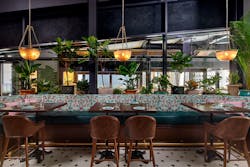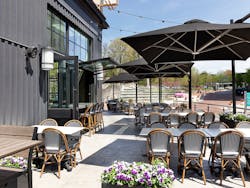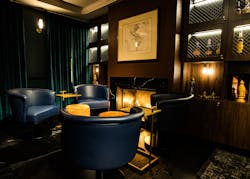Restaurants Design Trends for a Post-Pandemic World
The restaurant industry was one of the hardest hit by the COVID-19 pandemic, especially in the nation’s larger cities. With service restrictions, vaccine mandates and building regulations that were constantly evolving to accommodate surges in new variants and the change of seasons, many couldn’t keep up and were forced to close their doors. But those that survived, not to mention new builds in this nearing-an-endemic world, are entering fresh territory.
According to Restaurant Business Online, a recent state of the industry report from Yelp showed searches for indoor dining in Q1 2022 were up (wait for it) 6,360% compared to the same period two years ago, and outdoor dining up more than 1000% over the past two years. Overall, 13 million diners were seated through Yelp in Q1 at a 48% year-over-year increase.
So now that they’re back, what are they craving? We spoke with a few experts to see what “the new patron” wants when they take that seat at the table.
“Instagram-able” Moments
“Then once they’re in, that’s our opportunity to keep reinforcing it and keep building the relationship,” explained Sean Wilkinson, co-principal and creative director. And they do so with authentic elements which the firm ensures are so by pulling from their plentiful library of materials that includes sample books of paper, book binding clothes, match book samples and much more, for inspiration.
Most importantly, they collaborate closely with both interior design teams and head chefs to play off each other’s specialties, resulting in a cohesive storyline behind both space and plate. “We watch people make a special effort to move coasters, menus and the ‘little extras’ into their photo frame, creating shots that aren’t as forced and cheesy as a giant pair of wings painted outside,” Wilkinson said.
A Sense of Place
Diners are looking for spaces that represent a personal connection—whether that be to the location and community, the owner or chef themselves or even the designer’s muse. As a result, restaurants are no place for the big box experience any longer.
Grizform starts by developing a “big picture” aesthetic for each project. Whether that’s nautical or agricultural, for example, they craft a story behind it and decide on the right elements to incorporate. “I drive my family nuts because we’ll see a weird antique store on the side of the road that looks like it might have something that might be good for a restaurant, and I’m dragging everybody inside,” he laughed.
Another twist to the story can come when the restaurant is attached to a hard-branded hotel that’s trying to offer more custom-branded F&B appealing to locals and guests alike. “Travelers want more of a boutique experience while still feeling taken care of by a bigger name such as Hilton,” said Wilkinson. “And for the hotels, it infuses their common areas with much needed local authenticity, a more interesting culture and a stronger tie to the community they’re operating in.”
Outside Comes In
Once restaurant patrons were forced outside thanks to the pandemic, they realized how much they like the experience. Not only did they like it, but they’re still craving it, pushing designers to come up with new and inventive ways to continue blending indoor dining with out.
The former can also be used to reinforce that all important “story,” according to David Shove- Brown, partner at //3877, also in Washington D.C—the message that real ingredients are served here and we care about wellness in not just your food but also your surroundings. “We’re seeing people break away from design elements like reclaimed wood and white subway tiles, instead opting for more interesting aspects like biophilic elements and solid surface bar tops,” he said.
Musical Chairs (and Tables)
Proper space utilization is key in staying on alert for any unexpected phases of this post-pandemic era. That means steering clear of heavy built-ins when it comes to furniture.
“We do very few booths anymore because they aren’t adaptable,” said Shove-Brown. Smaller tables that can be modified to create a communal table, or pulled apart are way more sensible and result in less unused space.
At the end of the day, restaurant patrons are looking for unique dining experiences that give them a reason to step out over ordering takeout. Designers play a key role in bringing people back to the table, whether indoors or out, and ensuring their return to restaurants is memorable.
About the Author
AnnMarie Martin
Editor-in-Chief
AnnMarie is the former Editor in Chief of i+s and has been covering the commercial design space. Her style and vision has helped the brand evolve into a thought leader in purpose-driven design and cultural movements shaping the way we live and work.
